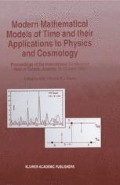Abstract
Gamma-Ray Burst (GRB) locations are distributed isotropically on the sky, but the intensity distribution of the bursts seems clearly incompatible with spatial homogeneity. Of the scenarios that attempt to provide an explanation, there are two that enjoy current popularity: (1) GRBs are produced by high-velocity neutron stars that have formed an extended (~100 kpc) spherical halo or ”corona” around our galaxy. (2) The bursters are at cosmological distances, with redshifts near unity for the weaker events. The major evidence used to argue for or against each of these scenarios remains inconclusive. Assuming, not unreasonably, that the cosmological scenario is correct, one can discuss the advantages and disadvantages of studying GRBs as opposed to other objects at moderate redshift. We find that the advantages of GRBs—high intensity, penetrating radiation, rapid variability, and no expected source evolution—are offset by observational difficulties pertaining to the extraction of cosmological information from GRB data. If the cosmological scenario proves to be correct and if the observational difficulties are overcome, then cosmologists certainly should care.
Access this chapter
Tax calculation will be finalised at checkout
Purchases are for personal use only
Preview
Unable to display preview. Download preview PDF.
References
Fenimore, E.E., Klebesadel, R.W., and Laros, J.G.: 1996, ApJ, 460
Fishman, G.J., and Meegan, C.A.: 1995, Ann. Rev. Astron. Astrophys., 33, 415
Fishman, Brainerd, and Hurley, Eds. 1994,: Gamma-Ray Bursts, (Proceedings of Gamma-Ray Burst Workshop - 1993, Huntsville, AL), AIP Conf. Proc. 307 (AIP Press- New York)
Lyne, A. and Lorimer, D.: 1994, Nature, 369, 127
Trimble, V.: 1994, Gamma-Ray Bursts (Proceedings of Gamma-Ray Burst Workshop -1993, Huntsville, AL), AIP Conf. Proc. 307 (AIP Press- New York), 717
Author information
Authors and Affiliations
Editor information
Editors and Affiliations
Rights and permissions
Copyright information
© 1997 Springer Science+Business Media Dordrecht
About this paper
Cite this paper
Laros, J.G. (1997). Gamma-Ray Bursts: Should Cosmologists Care?. In: Tifft, W.G., Cocke, W.J. (eds) Modern Mathematical Models of Time and their Applications to Physics and Cosmology. Springer, Dordrecht. https://doi.org/10.1007/978-94-011-5628-8_9
Download citation
DOI: https://doi.org/10.1007/978-94-011-5628-8_9
Publisher Name: Springer, Dordrecht
Print ISBN: 978-94-010-6372-2
Online ISBN: 978-94-011-5628-8
eBook Packages: Springer Book Archive

